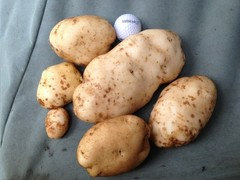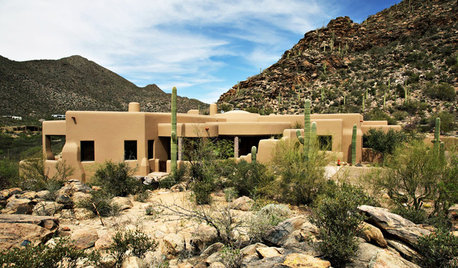Spanish River Carbonatite
Anyone use this or know where to get it?
I've come across info about it, but not a place to order it. Looks like a good way to fortify some trace elements and calcium , along with my compost additions.
Here is a link that might be useful: Spanish River Carbonatite
Comments (37)
Kimmsr
14 years agoThis appears to be a Canadian product not available in the USA. As they state clearly get a soil test before applying any so you know whether you need to spend money on it or not.
Related Professionals
Belmont Landscape Architects & Landscape Designers · Ashburn Landscape Contractors · Dallas Landscape Contractors · Dickinson Landscape Contractors · Harrisburg Landscape Contractors · Hicksville Landscape Contractors · Hoover Landscape Contractors · Leicester Landscape Contractors · Middleton Landscape Contractors · Royal Oak Landscape Contractors · San Carlos Park Landscape Contractors · Wanaque Landscape Contractors · Lauderdale Lakes Landscape Contractors · Crowley Landscape Contractors · Columbia Decks, Patios & Outdoor Enclosuresgargwarb
14 years agoIt's absolutley lime. They claim it has a calcium carbonate equivalence of 81%. In other words, applying 100 lbs. of this stuff would have the same effect as applying 81 lbs. of pure calcite lime (High grade domolite lime has a calcium carbonate equivalence of about 55%).
It also doesn't make any claims as far as providing trace elements. All they lay claim to is N, P, K, Ca and Mg.
And from reading the site, I'd bet money that if they had even the tiniest amount of trace elements necessary for plant growth, by golly they would make a selling point out of it.tapla (mid-Michigan, USDA z5b-6a)
14 years agoI would not use this product in mineral soils unless they were known to be deficient in Ca and high in Mg. Unbalanced ratios much outside of 2-4:1, Ca:Mg, can cause antagonistic deficiencies of either element. If you note, the Ca content of that product is 20X that of Mg. Since Mg is approx 125X more soluble than Ca, there would be a strong residual fraction of Ca left in the soil, which repeated applications would exacerbate. You would almost HAVE to regularly apply MgSO4 (Epsom salts) to keep the Ca:Mg ratio in line, and w/o soil testing you'd just be stumbling around in the dark.
I also wouldn't use it in containers w/o including regular applications of MgSO4 when you fertilize.
Al
cheffrank
Original Author14 years agoThanks for the feed back all. The reason I was curious is that I asked an organic farmer at our local farmers market what he uses aside from compost, to reinforce his soil. He did say that after soil tests he targets any defficiencies, but that he had been using volcanic rock dust mined in Idaho and sold under the trade name of Azomite, but was switching to SRC. I am still in the learning curve for organic gardening and still curious about all options. My practices to this point have been extremely minimal: soil tests and alot of compost mainly. Fish emulsion here and there, compost and alfalfa teas...just want to be sure I'm being a good gardener:)
livelydirt
11 years agoHi all. Picked up on this old thread because of my interest in SRC. The site I link to below may not have existed when this thread originated. You will find a really detailed chemical analysis for SRC as well as interesting field trial results. The stuff seems like "dynamite" for our gardens. I have obtained 50 lbs through one of the Directors and intend to use it this summer on my 1200 sq. ft. veggie garden. The company is in the process of getting a bagging plant up and running. They presently sell in one tonne bags and truckloads. I know they have many thousands of tonnes sold for delivery this spring. As a bonus for me, the stuff is mined about fifty miles from my home just north of Sudbury, ON. I think they are shipping truckloads to the States this year. It's certainly worth keeping an eye on. Some Market Gardeners in our area are now using the product.
Here is a link that might be useful: Boreal Agrominerals
ericwi
11 years agoI have never gardened with Spanish River carbonatite, but I have driven through and flown over the area. The trees, shrubs, and grasses do look particularly lush, as I remember. I think the area is well worth a visit.
Kimmsr
11 years agoIt still comes down to the same thing, have a good reliable soil test done to see if your soil might need this stuff, after you get your soil into shape with adequate amounts of organic matter. Aside from organic matter there simply is no "magic elixar" that will help your plants grow strong and healthy.
livelydirt
10 years agoHerman asked for a bit of an update...
Garlic harvest was best I've ever had. Sorry, no pic.
Harvested one hill of potatoes and have never had them this good. The yield, based on this one hill is about 10:1 at the minimum. Largest tater was 1lb. 11oz. or ~740gms.
I have one large pot of Basil - 5 plants. A friend looked at it and asked me if they were on steroids. Over twice the size of last year's offering.
I don't have any soil tests. Good ones cost an arm and a leg here.
Gargwarb, the site you were looking at is not the producers site. They have no connection with the miners. Check the site in the link and you will see that SRC is a potent cocktail of micronutrients that we farm out of our soil. The field trials are also good reading. The potato fields they tested on are a fifteen minute drive from my home and a half hour from the mine.
The company now has a bagging plant up and running. I bought 200 lbs as soon as I could, but had to get it directly from a VP of the company. I believe it will be marketed coast to coast in Canada next season, possibly through Home Hardware stores. Don't know about US distribution, but watch for it. I know it is trucked into the States by the transport load. They sold at least 50,000 tons this year. If you can find one of the buyers, they might sell you a bucket or two.

Here is a link that might be useful: Boreal Agrominerals
Slack
10 years agoHi my name is John Slack, with my father starting in 1994 commenced developing the Spanish River Carbonatite as a natural soil amendment. This journey started because of our passion for organic agriculture and our mineral background. It is my strongest opinion that agriculture will not achieve sustainability unless geology becomes an equal participant in this quest.
The role that geology plays in the proliferation of life on this planet is ignored. The greatest leaps in knowledge over the last 20 years has occurred in geology. This has resulted in recognizing that the weathering of rocks is responsible for the regulation of atmospheric CO2, the chemistry of water and the development of functioning soils. Perhaps the greatest revelation is life's contribution to the rock cycle. If not for life the geological forces that shape our planet would cease to exist; Earth would look like the moon.
The purpose of this dissertation is to suggest that soil restoration is re-establishing soil food webs through the improvement of microbial habitats. Improvement to microbial habitat cannot be accomplished without evaluating soil behavioral characteristics first. This would entail evaluating geological history, the resulting soil landscape, the inherent geochemical patterns and land use history. The common held belief that mineralogical change in soils happens in geological time has resulted in evaluating soil fertility from a biological prospective only. Input recommendations to improve soil fertility normally have only been evaluated from a plants nutritional needs and little emphasis was placed on evaluating the soil ecosystem. This has resulted in evaluating soil fertility and developing fertilizer inputs on solubility characteristics and chemistry. Geochemistry cycles within the soil are immensely complex and require the investigation of soil biological and mineralogical components. Determining mineral solubility characteristics of the soil system or potential mineral inputs does not determine nutrient requirements of plants. Evaluating soil geological characteristics, resulting, geochemical patterns, geochemical cycling and recognizing that microorganisms accelerate mineral transformation does.
For those contributors that have posted that Spanish River Carbonatite is nothing more then expensive limestone I would be happy to debate this fact and share some of the exciting projects we are undertaking to aid in helping to develop sustainable food production.
pnbrown
10 years agoIt's worth noting that big yields don't necessarily equal high quality. Regarding LivelyDirt's potato pics, a cool high-latitude climate is very conducive to big potato yields. Perhaps Lively could return and at least tell as the brix results on the tubers if not an ash test for total nutrient levels.
livelydirt
10 years agopnbrown... I've gardened this same soil for forty years, so it's not like I'm comparing a harvest here to a harvest in your balmy climate. My potatoes were healthy, taste very good,store very well, and are as organically produced as I can do. I've studied the chemical composition of SRC from their website, looked at their potato test plot results which are a fifteen minute drive from my home, and conclude that I am using a really great product.
Brix test, Ash test....are you kidding me? What home gardener performs such tests?
pnbrown
10 years agobrix is a simple matter of using a refractometer, I use it frequently. Not expensive, of course an ash test is.
Anyway, are you suggesting that SRC caused a big increase in yield over what you have noted as normal?
livelydirt
10 years agoYes, my yields were up at least 20% over my best previous years, and if I had paid more attention to a drier area near a large Birch tree, I would probably be 30% increase. My garlic was also the best I have ever had. Leek crop was a failure due to the Leek moth... Arghhhh... Bugs!!!
livelydirt
10 years agoOne of the issues I had was getting "organic" potassium into my taters. Wood ash works, but it causes scab. With SRC I have almost zero scab. Happy gardener!
gonebananas_gw
10 years agoCarbonatites originated as basically (excuse the pun) molten marble or ultimately molten limestone, and they probably started as limestone. The burial depth was so deep and the pressure so high that CO2 could not be driven off the calcium carbonate by the high heat. At the least they are agronomically as good as limestone and may be a bit better by the inclusion (perhaps once dissolved in the melt) of siliceous surrounding (host) rock. Still, many limestones have appreciable siliceous minerals (especially "marls"). It is hard to envision any miracle product (say as chemical nitrates may have seemed at the end of the "manuring" age, or trace metals in deficient areas) but it is probably a good product on acid or leached soils.
Kimmsr
10 years agoKeep in mind that Ma Nature does not import "stuff" from far away to build the soils she makes.
Keep in mind that harvesting and moving these minerals involves using up nonrenewable resources, something a bit contrary to organic practices.
Keep in mind that many of us, as well as our parents and grandparents, grew a lot of our food without these inputs using only locally available resources.pnbrown
10 years agoWhich is why in some cases geological regions are impoverished of certain elemental nutrients. The "goiter belt" is an example, the highly leached clays of the southeast are another, florida quartz sand is another. When people relied on home gardens and local staples for most of their sustenance in such regions, mineral deficiency problems were not uncommon.
In the florida sand it is known that eating only produce grown in the sand will lead quickly to deficiencies; the natives avoided this by eating large amounts of fish and other animals from rivers (rivers typically have much higher concentrations of minerals) and where possible from the ocean.
livelydirt
10 years agoKimmsr... Points understood...
I am writing this from a rather unique perspective. I live and thrive in Sudbury, Ontario, one of the oldest, active, largest deep underground mining camps in the world. Before our regreening efforts, it was also a world renown "brownfield". But wow, you should see us now! We are GREEN, and getting greener every day.
So before being too harsh on my gardening practices, please keep in mind that glaciation took ALL the soil from Northern Ontario and deposited it in the Corn Belt of the US Midwest.
Keep in mind that once a thin soil had redeveloped over thousands of years, industrialists came along and practiced "open bed roasting" of highly toxic sulphur rich nickel ores so you and the world could have stainless steel. The roasting killed every tree and blade of grass for over fifty miles downwind, then along came the rains and washed ALL the rootless soil off the hills and into the steams... Gone again, and gone also were the fish, killed by the acidic runoff.
Keep in mind that more industrialists came along and imported lime and fertiliser and grass seed, spreading it on the hills to feed the minuscule dead acidic soil in the cracks of the rocks. The supplements were spread by hand, by machine, and by crop dusters... Then over fourteen million trees have been replanted, and once again, thanks to "ecologically unfriendly" efforts, our hills are regreening and absorbing carbon dioxide from the atmosphere. Once again moose, bear, deer, are returning to our landscape, and fish are returning to our lakes and streams... and we've only just begun.
The glacial till I started gardening forty years ago is now a deep and rich organic soil, feeding us year round with unbelievably healthy food. I am leaving my little patch of earth a far better place than when I arrived on it.
And last but not least, keep in mind that SRC is mined from an old volcanic core fifty miles from my home... how fortunate for me.
Kimmsr
10 years agoLively, I am well aware of all of your points but keep in mind that the soil I have here, Lake Michigan beach sand, started many years ago with a soil pH of 5.7 and low levels of P, K, Ca, and Mg . After 3 years of adding just the compost I made the soil pH was 7.2 and the levels of P, K, Ca, and Mg went to high optimum and were in balance. The only thing imported from off the property were tree leaves from around town that others were throwing away.
I know a number of other organic growers, all over the world, that have seen similar results, and I have seen similar results in soils in Northwest Indiana and Southeast Ohio both clay soils. Adding nothing but organic matter changed those soils dramatically into good healthy soils that grew strong and healthy plants without spending money on exotic materials from far distant places.
Much more in keeping with the basic tenets of organic growing.pnbrown
10 years agoIt's true, no doubt, that a small area of soil can be greatly improved by the compost made from some of the vegetative growth from a larger area. Large deciduous trees are the easiest source. The resulting compost is good but exceedingly common. OM is very heavy and generally very unremarkable, and not worth hauling more than short distances (like from the compost pile to the garden).
However, certain mineral sources are extremely valuable, so valuable that they are worth hauling long distances. If an SRC mine were 50 miles from me, I'd be hitching up the dump trailer, you bet.
Slack
10 years agoI have enjoyed reading the debate regarding organic agriculture and the use of rock dust, in this case Spanish River Carbonatite.
Firstly, the one post regarding the origin of Carbonatites is incorrect. Carbonatites belong to the family of igneous rocks referred to as ultramafic, a very unique group of âÂÂhigh reactivityâÂÂ, mineralogically complex rock occurrences. No other igneous rocks have provoked such fascination. Ultramafic rocks, also described as alkalic rocks, have been subject to intense geological investigation over the past 50 years. The alkalic rocks are characterized by depth of magma sourced, rarity, high concentrations of volatiles (CO2, H2O, etc.), incompatible elements, lithophile elements, (lithophile elements are those with a strong affinity for oxygen, having a greater free energy of oxidation) and wide spectrum of rock and mineral types. The alkalic rock formation show a strong correlation with major continental fractures, which penetrate to the mantle (Sage, 1983). Ultramafic trends in North America are associated along the Pacific Rim of Fire and ancient tectonic boundaries. The overriding characteristic of alkalic rock formations is the incredible variations they exhibit in mineralogy, texture and grain size. The very best rock dust amendments produced in North America are often influenced or contained within these trends. Although akalic rocks comprise less than 1% of all igneous rocks one third of all rock names are designated alkaline, totaling more than 250; truly a testament to their mineral diversity.
Secondly, I personally have been a major advocate of compost. On our family farm no soil amendment does not include compost produced from the farm. Our formula is quite simple manure packs from our livestock, rock dust, a bucket or two of forest soil and finally wind rowing the blend. The reasoning behind adding mineral diverse rock dust is to stimulate beneficial microbial activity. By encouraging this the composting process creates stable carbon compounds in which solubilized rock dust is transferred onto exchange sites. The addition of rock dust also results in the release of silica and creation of essential secondary clay minerals.
Lastly, I have paraphrased Peter Van Straaten whimsical play on words "Rocks for Crops" to state "Local Rocks for Local Crops". This was done to advocate the use of local amendments to enrich and restore soils indefinitely. I look forward to the day when the Spanish River Carbonatite markets implode and this exceptional resource can be used to revitalize the Sudbury landscape. In the meantime our company continues to advocate the roll of rock dust in soil restoration and food nutrition and help interested parties find local mineral resources to be utilized in a carbon based fertility program.
pnbrown
10 years agoSlack, oftentimes a region has no available source of rock dust that has good agricultural value. For example, the island where I live. So importing it is very expensive, and thus great care has to be taken to choose the best value by weight.
Slack
10 years agoHi pnbrown
Where is your island? You maybe surprised at the availability of local amendments. Has there been historical quarrying for industrial use? What is the bedrock geology? If igneous you may find good quantities of biotite and mafic minerals, both comparable to well documented rock dust products. If sedimentary rocks there is the opportunity for good levels of beneficial clay found in shale, argilite, etc.
If you are willing an online evaluation of your regions geology would point you in the right direction. The beauty of the internet is the wealth geological information.
farm2
10 years agoHello pnbrown, I took a quick look at your zone - if you're located in Massachusetts, you're fortunate enough to be close to one of the top suppliers of rock dusts on the East Coast; Danny Kittredge from Nutrient Dense Supply. He is also connected with the www.remineralize.org (Remineralize the Earth) organization and NOFA (Northeast Organic Farming Association)
Here is a link that might be useful: Nutrient Dense Supply
pnbrown
10 years agoSlack, while I am not a geologist nor a serious expert in the geology of Dukes county MA, I do know it pretty well. I have studied the soil maps carefully. The only active mine on the island is located in the same materials as most gardeners here are dealing with, so buying anything there is unhelpful, and in any case they do not sift to the level of "dust". I have tried floating the fines out of their native crushed stone, and compared to using crushed stone that they import from Acushnet MA. The imported had superior results, although it's nothing much compared to super-active broad-spectrum stuff like the montmilloronite volcanic materials from the far west, such as Azomite.
Farm2, I know Dan and in fact have been to his place. It's not "close" to us, nothing really is since everything has to come over on a ferry. The most bang-for-the-buck amendment in our leached sandy soils - or even our small amounts of silty/clayey loam - is lime, because it is mass-produced and mass-distributed product. Even by the 50lb bag it's 6 or 7 bucks on the island, while stuff like Azomite or greensand (or SRC) are 40-50 bucks a bag and that may not include getting it here. And if one hires the lime truck or buys lime by the ton tote it is even much cheaper.
What is needed is for some of these broad-spectrum minerals to be mined and distributed on a scale closer to lime, so that it could be affordable.
Slack
10 years agoHi Bnbrown
I believe the very best bang for your buck is lime. All to often limestone is overlooked as a source of trace elements. Here in Southern Ontario we are blessed with soils formed from calcareous, (calcium rich) parent material which has resulted in exceptionally well developed, biologically active soils. I must apologize for the next long drawn out segment but I believe it is important to truly emphasize that limestone is much more then an amendment to buffer ones soils. With the immense interest in trace minerals resulting in sea based products entering the market place perhaps we should reevaluate limestone's role in concentrating ocean chemistry.
Southern Ontario is blessed because its geographic position ensured the formation of barrier reefs. Ocean convection currents resulted in an inestimable volume of nutrient latent water upwelling into shallow warm arid marine environments. Algae being plants require an abundance of light for photosynthesis. This means that the formation of modern shelf reefs occur in clear, relatively shallow sunlit water. Though shallow water is required it must be freely circulating with an abundance of food and oxygen. Modern reefs will only flourish with a temperature range of 77ð to 84ð F. Though the requirements for ancient reef forming organisms are not known, it is likely that the same restrictive conditions must have existed. These marine environments would have resulted in a proliferation of life, requiring a complexity of chemical constituents. Today ocean shelves account for four percent of the oceans area but approximately fifty percent of all marine life. This complexity of life filtering great volumes of chemical rich ocean waters built superlative coral structures and detritus rock formations. This chemical complexity in limestone and cemented clays was preserved to be utilized by later living systems under very different circumstances. Fortuitously, Southern Ontario soils formed from this rich limestone exhibit elevated geochemical profiles and abundant free carbonates.
Limestone is truly concentrated sea minerals containing a complexity of essential chemistry to perform the task of revitalizing your garden soil, provided it is put in contact with proper soil biology. To me this means compost, forest soil inoculation that contains fungi and bacteria that have evolved to recognize your unique landscape conditions.
I must admit I am a bit of calcium nut and spend a tremendous amount of time tracking its correlation with landscapes that produce the finest foods or support immense complex ecosystems.
pnbrown
10 years agoBeing a calcium nut is a good thing, I think, in most places. Certainly it would be hard to overdo calcium in most high-precipitation food-production environments. Sounds like southern Ontario has similar outstanding soils as much of the midwest, probably the soils there do not crave lime as much as eastern soils do.
gonebananas_gw
10 years ago"One Tonne [i.e., 1000 kg] of Spanish River Carbonatite contains:
650 kg of Calcium Carbonate
120 kg of Apatite (Phosphorus)
150 kg Biotite (Potassium Mica/Pyroxene/Vermiculite)http://www.borealagrominerals.com/src-minerals.html
Chemically almost exactly the same as a marly fossiliferous limestone. 65% calcium carbonate in any event.
livelydirt
10 years agogonebananas... besides having the good stuff you mention, I think the biggest benefit of SRC is the abundance of trace elements.
rouge21_gw (CDN Z5b/6a)
8 years agoI have used this product for the past 2 years but this year I am finding it hard to source (in the 20 kg bag). I have emailed the company with no reply.
livelydirt
8 years agoHi Chef Frank. Where do you live? I think Home Hardware is carrying it nationally
rouge21_gw (CDN Z5b/6a)
8 years agoNo it isn't.
It isn't on the HH site nor is HH shown on the SRC site.
















jean001